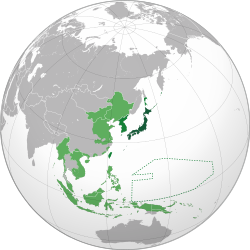Empire in the Asia-Pacific region from 1868 to 1947 From Wikipedia, the free encyclopedia
The Empire of Japan[c] (Japanese : 大日本帝國) also known as Imperial Japan was a historical Nation State and great power during the period from the Meiji Restoration to the Japanese defeat in World War II. It ruled the Home Islands of Japan and many other areas. The Emperors during this time, were Emperor Meiji (Mutsuhito), from 1868-1912 and Emperor Taishō (Yoshihito) from 1912-1926 and Emperor Shōwa (Hirohito) from 1926-1989. It is considered to go from the year 1868 to 1945. Hirohito was still emperor of Japan after the empire dissolved in 1947. Hirohito was emperor of Japan until his death in 1989.
Empire of Japan
| |||||||||||
|---|---|---|---|---|---|---|---|---|---|---|---|
| 1868–1947 | |||||||||||
Motto:
| |||||||||||
| Anthem: (1869–1945) "Kimigayo" (君が代) | |||||||||||
 The Empire of Japan at its peak in 1942:
| |||||||||||
| Capital |
| ||||||||||
| Largest city |
| ||||||||||
| Official languages | Japanese | ||||||||||
| Recognised regional languages | |||||||||||
| Religion | |||||||||||
| Government | Unitary parliamentary semi-constitutional monarchy (1889–1947) (de jure)[7] Unitary divine theocratic absolute monarchy (de facto)
| ||||||||||
| Emperor | |||||||||||
• 1868–1912 | Meiji | ||||||||||
• 1912–1926 | Taishō | ||||||||||
• 1926–1947 | Shōwa | ||||||||||
| Prime Minister | |||||||||||
• 1885–1888 (first) | Itō Hirobumi | ||||||||||
• 1946–1947 (last) | Shigeru Yoshida | ||||||||||
| Legislature | None (rule by decree) (1868-1871) House of Peers (1871-1889) Imperial Diet (since 1889) | ||||||||||
| House of Peers (1889-1947) | |||||||||||
| House of Representatives (from 1890) | |||||||||||
| Historical era | Meiji • Taishō • Shōwa | ||||||||||
| 3 January 1868[9] | |||||||||||
| 11 February 1889 | |||||||||||
| 25 July 1894 | |||||||||||
| 8 February 1904 | |||||||||||
| 23 August 1914 | |||||||||||
| 18 September 1931 | |||||||||||
| 7 July 1937 | |||||||||||
| 7 December 1941 | |||||||||||
| 2 September 1945 | |||||||||||
| 3 May 1947[7] | |||||||||||
| Area | |||||||||||
| 1938[10] | 1,984,000 km2 (766,000 sq mi) | ||||||||||
| 1942[11] | 7,400,000 km2 (2,900,000 sq mi) | ||||||||||
| Population | |||||||||||
• 1920 | 77,700,000a | ||||||||||
• 1940 | 105,200,000b | ||||||||||
| Currency |
| ||||||||||
| |||||||||||
| Japanese Empire | |||||
| Japanese name | |||||
|---|---|---|---|---|---|
| Kanji | 大日本帝国 | ||||
| Hiragana | だいにっぽんていこく だいにほんていこく | ||||
| Katakana | ダイニッポンテイコク ダイニホンテイコク | ||||
| Kyūjitai | 大日本帝國 | ||||
| |||||
In those years, Japan changed greatly. It became one of the most powerful countries in the world. Japan built a powerful Imperial Japanese Armed Forces (IJA and IJN), and changed from an agricultural to an industrial economy. The Japanese began to invade and occupy other near countries like Korea, Taiwan, Manchukuo and part of China to get natural resources.
The Empire of Japan surrendered to the Allies on September 2, 1945, after a long war against the Allied nations of World War II ending with the atomic bombings of Hiroshima and Nagasaki. The Allies occupied the country and made many changes, including a new constitution. Allied occupation and reconstruction of the country continued well into the 1950s.
Seamless Wikipedia browsing. On steroids.